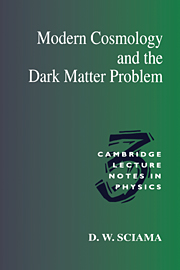Book contents
- Frontmatter
- Contents
- Preface
- Recent Developments
- Part One Dark Matter in Astronomy and Cosmology
- 1 Dark Matter in Galaxies
- 2 Dark Matter in Clusters of Galaxies
- 3 Dark Matter in Intergalactic Space
- 4 The Identity of the Dark Matter
- Part Two Ionisation Problems in Astronomy and Cosmology
- Part Three Neutrino Decay and Ionisation in the Universe
- Part Four Observational Searches for the Neutrino Decay Line
- References
- Subject index
3 - Dark Matter in Intergalactic Space
Published online by Cambridge University Press: 11 January 2010
- Frontmatter
- Contents
- Preface
- Recent Developments
- Part One Dark Matter in Astronomy and Cosmology
- 1 Dark Matter in Galaxies
- 2 Dark Matter in Clusters of Galaxies
- 3 Dark Matter in Intergalactic Space
- 4 The Identity of the Dark Matter
- Part Two Ionisation Problems in Astronomy and Cosmology
- Part Three Neutrino Decay and Ionisation in the Universe
- Part Four Observational Searches for the Neutrino Decay Line
- References
- Subject index
Summary
Introduction
The idea that there may be significant quantities of dark matter distributed smoothly throughout the universe as a whole developed gradually. In its modern formulation the idea is based on a number of considerations. The first concerns the role played by the mean density of the universe in the cosmological models of general relativity. These models have a fundamental status in discussions of cosmological dark matter, and so we devote much of this chapter to an account of them.
The second consideration concerns the mean density of ordinary matter in the universe. By “ordinary matter” I mean atoms, neutral or ionised, which are collectively referred to as baryonic. Estimates have been made of the contribution of visible baryons to the mean density of the universe using direct astronomical measurements. An estimate has also been made, using indirect arguments, of the total contribution of baryons, visible and invisible, to the mean density. This estimate is based on a comparison of the measured abundances of certain light elements (D, He3, He4 and Li7) with the calculated output of thermonuclear reactions occurring in the “first three minutes” after the hot big bang origin of the universe. These arguments will also be described in this chapter. We shall find that, according to modern estimates, the mean density in visible baryons is significantly less than the total mean density in baryons. If these estimates are correct, an appreciable number of baryons must be dark.
The third consideration concerns the contribution of nonbaryonic matter to the mean density of the universe. Various forms of more or less “exotic” matter have been proposed under this heading.
- Type
- Chapter
- Information
- Modern Cosmology and the Dark Matter Problem , pp. 17 - 60Publisher: Cambridge University PressPrint publication year: 1994

